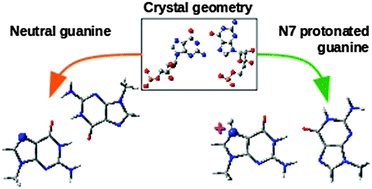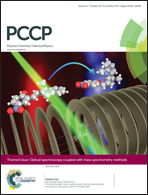The role of N7 protonation of guanine in determining the structure, stability and function of RNA base pairs†
Abstract
The roles of protonated nucleobases in stabilizing different structural motifs and in facilitating catalytic functions of RNA are well known. Among different polar sites of all the nucleobases, N7 of guanine has the highest protonation propensity at physiological pH. However, unlike other easily protonable sites such as N1 and N3 of adenine or N3 of cytosine, N7 protonation of guanine does not lead to the stabilization of base pairs involving its protonated Hoogsteen edge. It also does not facilitate its participation in any acid–base catalysis process. To explore the possible roles of N7 protonated guanine, we have studied its base pairing potentials involving WatsonCrick and sugar edges, which undergo major charge redistribution upon N7 protonation. We have carried out quantum chemical geometry optimization at the M05-2X/6-311G+(2d,2p) level, followed by interaction energy calculation at the MP2/aug-cc-pVDZ level, along with the analysis of the context of occurrence for selected base pairs involving the sugar edge or the WatsonCrick edge of guanine within a non-redundant set of 167 RNA crystal structures. Our results suggest that, four base pairs – G:C W:W trans, G:rC W:S cis, G:G W:H cis and G:G S:H trans may involve N7 protonated guanine. These base pairs deviate significantly from their respective experimental geometries upon QM optimization, but they retain their experimental geometries if guanine N7 protonation is considered during optimization. Our study also reveals the role of guanine N7 protonation (i) in stabilizing important RNA structural motifs, (ii) in providing a framework for designing pH driven molecular motors and (iii) in providing an alternative strategy to mimic the effect of post-transcriptional changes.



 Please wait while we load your content...
Please wait while we load your content...